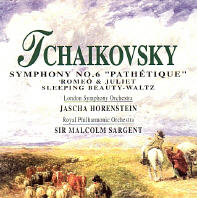
The third movement also deceives. It begins as a scherzo but gradually betrays its true nature as a rousing march. Then comes the most unexpected movement of all: a finale that is a lament - one might say a lament unto death. Early audiences were disturbed by the ending in utter darkness and confused by the uniquely unconventional plan of the whole work, so success came slowly. Tchaikovsky, who had conducted the first performance, did dot live to see that success. He died nine days later.
Romeo and Juliet depicts characters and events in Shakespeare's play rather than following the story. Friar Laurence's devout theme opens the work, the grim vendetta between the Montagues and Capulets follows, and this gives way to the famous 'love theme'. In the development tension rises ever higher, reaching the fierce sword battle and leading into the love theme, greatly intensified by events. Tchaikovsky depicts the tragic outcome with graphic skill.
After so passionate a programme, the Sleeping Beauty Waltz comes as a relaxing encore.
Robert Dearling.
Discontinued
Symphony No. 6
'Pathétique'
